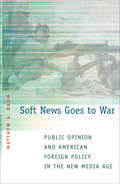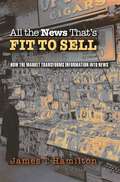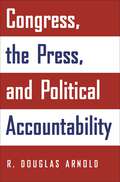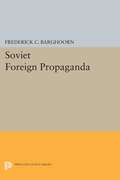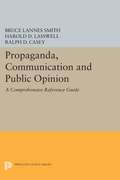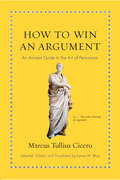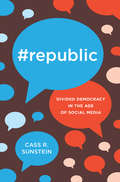- Table View
- List View
Soft News Goes to War: Public Opinion and American Foreign Policy in the New Media Age
by Matthew A. BaumThe American public has consistently declared itself less concerned with foreign affairs in the post-Cold War era, even after 9/11, than at any time since World War II. How can it be, then, that public attentiveness to U.S. foreign policy crises has increased? This book represents the first systematic attempt to explain this apparent paradox. Matthew Baum argues that the answer lies in changes to television's presentation of political information. In so doing he develops a compelling "byproduct" theory of information consumption. The information revolution has fundamentally changed the way the mass media, especially television, covers foreign policy. Traditional news has been repackaged into numerous entertainment-oriented news programs and talk shows. By transforming political issues involving scandal or violence (especially attacks against America) into entertainment, the "soft news" media have actually captured more viewers who will now follow news about foreign crises, due to its entertainment value, even if they remain uninterested in foreign policy. Baum rigorously tests his theory through content analyses of traditional and soft news media coverage of various post-WWII U.S. foreign crises and statistical analyses of public opinion surveys. The results hold key implications for the future of American politics and foreign policy. For instance, watching soft news reinforces isolationism among many inattentive Americans. Scholars, political analysts, and even politicians have tended to ignore the soft news media and politically disengaged citizens. But, as this well-written book cogently demonstrates, soft news viewers represent a largely untapped reservoir of unusually persuadable voters.
Soft News Goes to War: Public Opinion and American Foreign Policy in the New Media Age
by Matthew A. BaumThe American public has consistently declared itself less concerned with foreign affairs in the post-Cold War era, even after 9/11, than at any time since World War II. How can it be, then, that public attentiveness to U.S. foreign policy crises has increased? This book represents the first systematic attempt to explain this apparent paradox. Matthew Baum argues that the answer lies in changes to television's presentation of political information. In so doing he develops a compelling "byproduct" theory of information consumption. The information revolution has fundamentally changed the way the mass media, especially television, covers foreign policy. Traditional news has been repackaged into numerous entertainment-oriented news programs and talk shows. By transforming political issues involving scandal or violence (especially attacks against America) into entertainment, the "soft news" media have actually captured more viewers who will now follow news about foreign crises, due to its entertainment value, even if they remain uninterested in foreign policy. Baum rigorously tests his theory through content analyses of traditional and soft news media coverage of various post-WWII U.S. foreign crises and statistical analyses of public opinion surveys. The results hold key implications for the future of American politics and foreign policy. For instance, watching soft news reinforces isolationism among many inattentive Americans. Scholars, political analysts, and even politicians have tended to ignore the soft news media and politically disengaged citizens. But, as this well-written book cogently demonstrates, soft news viewers represent a largely untapped reservoir of unusually persuadable voters.
All the News That’s Fit to Sell: How the Market Transforms Information into News
by James T. HamiltonThat market forces drive the news is not news. Whether a story appears in print, on television, or on the Internet depends on who is interested, its value to advertisers, the costs of assembling the details, and competitors' products. But in All the News That's Fit to Sell, economist James Hamilton shows just how this happens. Furthermore, many complaints about journalism--media bias, soft news, and pundits as celebrities--arise from the impact of this economic logic on news judgments. This is the first book to develop an economic theory of news, analyze evidence across a wide range of media markets on how incentives affect news content, and offer policy conclusions. Media bias, for instance, was long a staple of the news. Hamilton's analysis of newspapers from 1870 to 1900 reveals how nonpartisan reporting became the norm. A hundred years later, some partisan elements reemerged as, for example, evening news broadcasts tried to retain young female viewers with stories aimed at their (Democratic) political interests. Examination of story selection on the network evening news programs from 1969 to 1998 shows how cable competition, deregulation, and ownership changes encouraged a shift from hard news about politics toward more soft news about entertainers. Hamilton concludes by calling for lower costs of access to government information, a greater role for nonprofits in funding journalism, the development of norms that stress hard news reporting, and the defining of digital and Internet property rights to encourage the flow of news. Ultimately, this book shows that by more fully understanding the economics behind the news, we will be better positioned to ensure that the news serves the public good.
All the News That’s Fit to Sell: How the Market Transforms Information into News (PDF)
by James T. HamiltonThat market forces drive the news is not news. Whether a story appears in print, on television, or on the Internet depends on who is interested, its value to advertisers, the costs of assembling the details, and competitors' products. But in All the News That's Fit to Sell, economist James Hamilton shows just how this happens. Furthermore, many complaints about journalism--media bias, soft news, and pundits as celebrities--arise from the impact of this economic logic on news judgments. This is the first book to develop an economic theory of news, analyze evidence across a wide range of media markets on how incentives affect news content, and offer policy conclusions. Media bias, for instance, was long a staple of the news. Hamilton's analysis of newspapers from 1870 to 1900 reveals how nonpartisan reporting became the norm. A hundred years later, some partisan elements reemerged as, for example, evening news broadcasts tried to retain young female viewers with stories aimed at their (Democratic) political interests. Examination of story selection on the network evening news programs from 1969 to 1998 shows how cable competition, deregulation, and ownership changes encouraged a shift from hard news about politics toward more soft news about entertainers. Hamilton concludes by calling for lower costs of access to government information, a greater role for nonprofits in funding journalism, the development of norms that stress hard news reporting, and the defining of digital and Internet property rights to encourage the flow of news. Ultimately, this book shows that by more fully understanding the economics behind the news, we will be better positioned to ensure that the news serves the public good.
Congress, the Press, and Political Accountability
by R. Douglas ArnoldCongress, the Press, and Political Accountability is the first large-scale examination of how local media outlets cover members of the United States Congress. Douglas Arnold asks: do local newspapers provide the information citizens need in order to hold representatives accountable for their actions in office? In contrast with previous studies, which largely focused on the campaign period, he tests various hypotheses about the causes and consequences of media coverage by exploring coverage during an entire congressional session. Using three samples of local newspapers from across the country, Arnold analyzes all coverage over a two-year period--every news story, editorial, opinion column, letter, and list. First he investigates how twenty-five newspapers covered twenty-five local representatives; and next, how competing newspapers in six cities covered their corresponding legislators. Examination of an even larger sample, sixty-seven newspapers and 187 representatives, shows why some newspapers cover legislators more thoroughly than do other papers. Arnold then links the coverage data with a large public opinion survey to show that the volume of coverage affects citizens' awareness of representatives and challengers. The results show enormous variation in coverage. Some newspapers cover legislators frequently, thoroughly, and accessibly. Others--some of them famous for their national coverage--largely ignore local representatives. The analysis also confirms that only those incumbents or challengers in the most competitive races, and those who command huge sums of money, receive extensive coverage.
Congress, the Press, and Political Accountability (PDF)
by R. Douglas ArnoldCongress, the Press, and Political Accountability is the first large-scale examination of how local media outlets cover members of the United States Congress. Douglas Arnold asks: do local newspapers provide the information citizens need in order to hold representatives accountable for their actions in office? In contrast with previous studies, which largely focused on the campaign period, he tests various hypotheses about the causes and consequences of media coverage by exploring coverage during an entire congressional session. Using three samples of local newspapers from across the country, Arnold analyzes all coverage over a two-year period--every news story, editorial, opinion column, letter, and list. First he investigates how twenty-five newspapers covered twenty-five local representatives; and next, how competing newspapers in six cities covered their corresponding legislators. Examination of an even larger sample, sixty-seven newspapers and 187 representatives, shows why some newspapers cover legislators more thoroughly than do other papers. Arnold then links the coverage data with a large public opinion survey to show that the volume of coverage affects citizens' awareness of representatives and challengers. The results show enormous variation in coverage. Some newspapers cover legislators frequently, thoroughly, and accessibly. Others--some of them famous for their national coverage--largely ignore local representatives. The analysis also confirms that only those incumbents or challengers in the most competitive races, and those who command huge sums of money, receive extensive coverage.
A Social Strategy: How We Profit from Social Media
by Mikolaj Jan PiskorskiAlmost no one had heard of social media a decade ago, but today websites such as Facebook, Twitter, and LinkedIn have more than 1 billion users and account for almost 25 percent of Internet use. Practically overnight, social media seems indispensable to our lives--from friendship and dating to news and business.What makes social media so different from traditional media? Answering that question is the key to making social media work for any business, argues Miko?aj Piskorski, one of the world's leading experts on the business of social media. In A Social Strategy, he provides the most convincing answer yet, one backed by original research, data, and case studies from companies such as Nike and American Express.Drawing on his analysis of proprietary data from social media sites, Piskorski argues that the secret of successful ones is that they allow people to fulfill social needs that either can’t be met offline or can be met only at much greater cost. This insight provides the key to how companies can leverage social platforms to create a sustainable competitive advantage. Companies need to help people interact with each other before they will promote products to their friends or help companies in other ways. Done right, a company’s social media should benefit customers and the firm. Piskorski calls this "a social strategy," and he describes how companies such as Yelp and Zynga have done it.Groundbreaking and important, A Social Strategy provides not only a story- and data-driven explanation for the explosion of social media but also an invaluable, concrete road map for any company that wants to tap the marketing potential of this remarkable phenomenon.
A Social Strategy: How We Profit from Social Media (PDF)
by Mikolaj Jan PiskorskiAlmost no one had heard of social media a decade ago, but today websites such as Facebook, Twitter, and LinkedIn have more than 1 billion users and account for almost 25 percent of Internet use. Practically overnight, social media seems indispensable to our lives--from friendship and dating to news and business.What makes social media so different from traditional media? Answering that question is the key to making social media work for any business, argues Miko?aj Piskorski, one of the world's leading experts on the business of social media. In A Social Strategy, he provides the most convincing answer yet, one backed by original research, data, and case studies from companies such as Nike and American Express.Drawing on his analysis of proprietary data from social media sites, Piskorski argues that the secret of successful ones is that they allow people to fulfill social needs that either can’t be met offline or can be met only at much greater cost. This insight provides the key to how companies can leverage social platforms to create a sustainable competitive advantage. Companies need to help people interact with each other before they will promote products to their friends or help companies in other ways. Done right, a company’s social media should benefit customers and the firm. Piskorski calls this "a social strategy," and he describes how companies such as Yelp and Zynga have done it.Groundbreaking and important, A Social Strategy provides not only a story- and data-driven explanation for the explosion of social media but also an invaluable, concrete road map for any company that wants to tap the marketing potential of this remarkable phenomenon.
Publishing, Printing, and the Origins of the Intellectual Life in Russia, 1700-1800
by Gary MarkerGary Marker describes the pursuit of an effective public voice by political, Church, and literary elites in Russia as synonymous with the struggle to control the printed media, showing that Russian publishing and printing evolved in a way that sharply diverged from Western experiences but that proved to be highly significant for Russian society.Originally published in 1985.The Princeton Legacy Library uses the latest print-on-demand technology to again make available previously out-of-print books from the distinguished backlist of Princeton University Press. These editions preserve the original texts of these important books while presenting them in durable paperback and hardcover editions. The goal of the Princeton Legacy Library is to vastly increase access to the rich scholarly heritage found in the thousands of books published by Princeton University Press since its founding in 1905.
Public Service Liberalism: Telecommunications and Transitions in Public Policy
by Alan StoneIdentifying a form of government intervention in social and economic affairs called public service liberalism, Alan Stone looks to that ideology to confront the problems of the 1990s and beyond. He shows in this fascinating case study that the policy has been effective in the past: the American telephone industry from its inception until 1934 is an illustration of how public service liberalism served both economic efficiency and a complex structure of public values. Stone depicts the stages by which public service liberalism was replaced by less adequate policies and suggests ways that it could be successfully restored. Furthermore, Stone demonstrates that government-business relationships like the one that prevailed in the telephone industry were common in the nineteenth and the early twentieth century. He argues that this period was not an era of laissez-faire, as is often alleged, but that its economic energy and extraordinary technological progress were accompanied by complete acceptance of certain kinds of government intervention. Challenging the presuppositions not only of the new ideologists of deregulation, privatization, and competition but also of the practitioners of what he calls the "sanctimonious muddle" of present-day liberalism, Stone demonstrates that public service liberalism could help resolve current problems, such as those in the savings and loan institutions and the cable television industry.Originally published in 1991.The Princeton Legacy Library uses the latest print-on-demand technology to again make available previously out-of-print books from the distinguished backlist of Princeton University Press. These editions preserve the original texts of these important books while presenting them in durable paperback and hardcover editions. The goal of the Princeton Legacy Library is to vastly increase access to the rich scholarly heritage found in the thousands of books published by Princeton University Press since its founding in 1905.
How Propaganda Works
by Jason StanleyOur democracy today is fraught with political campaigns, lobbyists, liberal media, and Fox News commentators, all using language to influence the way we think and reason about public issues. Even so, many of us believe that propaganda and manipulation aren't problems for us—not in the way they were for the totalitarian societies of the mid-twentieth century. In How Propaganda Works, Jason Stanley demonstrates that more attention needs to be paid. He examines how propaganda operates subtly, how it undermines democracy—particularly the ideals of democratic deliberation and equality—and how it has damaged democracies of the past.Focusing on the shortcomings of liberal democratic states, Stanley provides a historically grounded introduction to democratic political theory as a window into the misuse of democratic vocabulary for propaganda's selfish purposes. He lays out historical examples, such as the restructuring of the US public school system at the turn of the twentieth century, to explore how the language of democracy is sometimes used to mask an undemocratic reality. Drawing from a range of sources, including feminist theory, critical race theory, epistemology, formal semantics, educational theory, and social and cognitive psychology, he explains how the manipulative and hypocritical declaration of flawed beliefs and ideologies arises from and perpetuates inequalities in society, such as the racial injustices that commonly occur in the United States.How Propaganda Works shows that an understanding of propaganda and its mechanisms is essential for the preservation and protection of liberal democracies everywhere.
How Propaganda Works
by Jason StanleyOur democracy today is fraught with political campaigns, lobbyists, liberal media, and Fox News commentators, all using language to influence the way we think and reason about public issues. Even so, many of us believe that propaganda and manipulation aren't problems for us—not in the way they were for the totalitarian societies of the mid-twentieth century. In How Propaganda Works, Jason Stanley demonstrates that more attention needs to be paid. He examines how propaganda operates subtly, how it undermines democracy—particularly the ideals of democratic deliberation and equality—and how it has damaged democracies of the past.Focusing on the shortcomings of liberal democratic states, Stanley provides a historically grounded introduction to democratic political theory as a window into the misuse of democratic vocabulary for propaganda's selfish purposes. He lays out historical examples, such as the restructuring of the US public school system at the turn of the twentieth century, to explore how the language of democracy is sometimes used to mask an undemocratic reality. Drawing from a range of sources, including feminist theory, critical race theory, epistemology, formal semantics, educational theory, and social and cognitive psychology, he explains how the manipulative and hypocritical declaration of flawed beliefs and ideologies arises from and perpetuates inequalities in society, such as the racial injustices that commonly occur in the United States.How Propaganda Works shows that an understanding of propaganda and its mechanisms is essential for the preservation and protection of liberal democracies everywhere.
Printed Propaganda under Louis XIV: Absolute Monarchy and Public Opinion
by Joseph KlaitsIn the late seventeenth century the role of printed propaganda in manipulating public consciousness became increasingly explicit, and governments developed systematic controls over the printed word. This book considers the purposes, mechanisms, content, and audience of royal printed propaganda in early modern France. The author first sketches the impact of the invention of printing and characterizes propaganda generally during the reign of Louis XIV. In succeeding chapters he discusses the theory and practice of censorship and the government's relationships with the recently established French periodical press, presenting a balanced portrait of the crown's objectives and mixed success in influencing the sources of opinion. The varieties of government-inspired pamphlet propaganda are carefully and extensively analyzed, and signed royal propaganda receives special attention.Originally published in 1977.The Princeton Legacy Library uses the latest print-on-demand technology to again make available previously out-of-print books from the distinguished backlist of Princeton University Press. These editions preserve the original texts of these important books while presenting them in durable paperback and hardcover editions. The goal of the Princeton Legacy Library is to vastly increase access to the rich scholarly heritage found in the thousands of books published by Princeton University Press since its founding in 1905.
How the Internet Became Commercial: Innovation, Privatization, and the Birth of a New Network
by Shane GreensteinIn less than a decade, the Internet went from being a series of loosely connected networks used by universities and the military to the powerful commercial engine it is today. This book describes how many of the key innovations that made this possible came from entrepreneurs and iconoclasts who were outside the mainstream—and how the commercialization of the Internet was by no means a foregone conclusion at its outset.Shane Greenstein traces the evolution of the Internet from government ownership to privatization to the commercial Internet we know today. This is a story of innovation from the edges. Greenstein shows how mainstream service providers that had traditionally been leaders in the old-market economy became threatened by innovations from industry outsiders who saw economic opportunities where others didn't—and how these mainstream firms had no choice but to innovate themselves. New models were tried: some succeeded, some failed. Commercial markets turned innovations into valuable products and services as the Internet evolved in those markets. New business processes had to be created from scratch as a network originally intended for research and military defense had to deal with network interconnectivity, the needs of commercial users, and a host of challenges with implementing innovative new services.How the Internet Became Commercial demonstrates how, without any central authority, a unique and vibrant interplay between government and private industry transformed the Internet.
How the Internet Became Commercial: Innovation, Privatization, and the Birth of a New Network
by Shane GreensteinIn less than a decade, the Internet went from being a series of loosely connected networks used by universities and the military to the powerful commercial engine it is today. This book describes how many of the key innovations that made this possible came from entrepreneurs and iconoclasts who were outside the mainstream—and how the commercialization of the Internet was by no means a foregone conclusion at its outset.Shane Greenstein traces the evolution of the Internet from government ownership to privatization to the commercial Internet we know today. This is a story of innovation from the edges. Greenstein shows how mainstream service providers that had traditionally been leaders in the old-market economy became threatened by innovations from industry outsiders who saw economic opportunities where others didn't—and how these mainstream firms had no choice but to innovate themselves. New models were tried: some succeeded, some failed. Commercial markets turned innovations into valuable products and services as the Internet evolved in those markets. New business processes had to be created from scratch as a network originally intended for research and military defense had to deal with network interconnectivity, the needs of commercial users, and a host of challenges with implementing innovative new services.How the Internet Became Commercial demonstrates how, without any central authority, a unique and vibrant interplay between government and private industry transformed the Internet.
Soviet Foreign Propaganda
by Frederick Charles BarghoornIndividual sections of this significant work have been edited and annotated by such outstanding scholars as Robert J. Alexander, Frederick C. Barghoorn, George F. Kennan, and others.Originally published in 1964.The Princeton Legacy Library uses the latest print-on-demand technology to again make available previously out-of-print books from the distinguished backlist of Princeton University Press. These editions preserve the original texts of these important books while presenting them in durable paperback and hardcover editions. The goal of the Princeton Legacy Library is to vastly increase access to the rich scholarly heritage found in the thousands of books published by Princeton University Press since its founding in 1905.
Propaganda, Communication and Public Opinion
by Bruce Lannes Smith Harold D. Lasswell"The most comprehensive bibliography yet published in the public opinion field." —Journalism Quarterly. Besides a selection of the most significant titles from earlier years, this book contains a comprehensive listing of books, pamphlets, and articles which appeared between 1934 and 1943.Originally published in 1946.The Princeton Legacy Library uses the latest print-on-demand technology to again make available previously out-of-print books from the distinguished backlist of Princeton University Press. These editions preserve the original texts of these important books while presenting them in durable paperback and hardcover editions. The goal of the Princeton Legacy Library is to vastly increase access to the rich scholarly heritage found in the thousands of books published by Princeton University Press since its founding in 1905.
Learning Through Storytelling In Higher Education: Using Reflection And Experience To Improve Learning (PDF)
by Janice Mcdrury Maxine AlterioLearning Through Storytelling in Higher Educationexplores ways of using storytelling as a teaching and learning tool. When storytelling is formalized in meaningful ways, it can capture everyday examples of practice and turn them into an opportunity to learn - encouraging both reflection, a deeper understanding of a topic and stimulating critical thinking skills. The technique can accommodate diverse cultural, emotional and experiential incidents, and may be used in many different contexts eg formal/informal; one-on-one/group setting. The authors outline the different models of storytelling and explain how to make use of this technique and encourage a 'storytelling culture' within the workplace or in tutorial sessions. Academic yet accessible, this book provides a new perspective on learning techniques and will be a great asset to any educator looking to improve reflective practice.
How to Win an Argument: An Ancient Guide to the Art of Persuasion
by Marcus Tullius Cicero James M. MayAll of us are faced countless times with the challenge of persuading others, whether we're trying to win a trivial argument with a friend or convince our coworkers about an important decision. Instead of relying on untrained instinct—and often floundering or failing as a result—we’d win more arguments if we learned the timeless art of verbal persuasion, rhetoric. How to Win an Argument gathers the rhetorical wisdom of Cicero, ancient Rome’s greatest orator, from across his works and combines it with passages from his legal and political speeches to show his powerful techniques in action. The result is an enlightening and entertaining practical introduction to the secrets of persuasive speaking and writing—including strategies that are just as effective in today’s offices, schools, courts, and political debates as they were in the Roman forum.How to Win an Argument addresses proof based on rational argumentation, character, and emotion; the parts of a speech; the plain, middle, and grand styles; how to persuade no matter what audience or circumstances you face; and more. Cicero’s words are presented in lively translations, with illuminating introductions; the book also features a brief biography of Cicero, a glossary, suggestions for further reading, and an appendix of the original Latin texts.Astonishingly relevant, this unique anthology of Cicero’s rhetorical and oratorical wisdom will be enjoyed by anyone who ever needs to win arguments and influence people—in other words, all of us.
How to Win an Argument: An Ancient Guide to the Art of Persuasion
by Marcus Tullius Cicero James M. MayAll of us are faced countless times with the challenge of persuading others, whether we're trying to win a trivial argument with a friend or convince our coworkers about an important decision. Instead of relying on untrained instinct—and often floundering or failing as a result—we’d win more arguments if we learned the timeless art of verbal persuasion, rhetoric. How to Win an Argument gathers the rhetorical wisdom of Cicero, ancient Rome’s greatest orator, from across his works and combines it with passages from his legal and political speeches to show his powerful techniques in action. The result is an enlightening and entertaining practical introduction to the secrets of persuasive speaking and writing—including strategies that are just as effective in today’s offices, schools, courts, and political debates as they were in the Roman forum.How to Win an Argument addresses proof based on rational argumentation, character, and emotion; the parts of a speech; the plain, middle, and grand styles; how to persuade no matter what audience or circumstances you face; and more. Cicero’s words are presented in lively translations, with illuminating introductions; the book also features a brief biography of Cicero, a glossary, suggestions for further reading, and an appendix of the original Latin texts.Astonishingly relevant, this unique anthology of Cicero’s rhetorical and oratorical wisdom will be enjoyed by anyone who ever needs to win arguments and influence people—in other words, all of us.
#Republic: Divided Democracy in the Age of Social Media
by Cass R. SunsteinFrom the New York Times bestselling author of Nudge and The World According to Star Wars, a revealing account of how today's Internet threatens democracy—and what can be done about itAs the Internet grows more sophisticated, it is creating new threats to democracy. Social media companies such as Facebook can sort us ever more efficiently into groups of the like-minded, creating echo chambers that amplify our views. It's no accident that on some occasions, people of different political views cannot even understand each other. It's also no surprise that terrorist groups have been able to exploit social media to deadly effect.Welcome to the age of #Republic.In this revealing book, Cass Sunstein, the New York Times bestselling author of Nudge and The World According to Star Wars, shows how today's Internet is driving political fragmentation, polarization, and even extremism—and what can be done about it.Thoroughly rethinking the critical relationship between democracy and the Internet, Sunstein describes how the online world creates "cybercascades," exploits "confirmation bias," and assists "polarization entrepreneurs." And he explains why online fragmentation endangers the shared conversations, experiences, and understandings that are the lifeblood of democracy.In response, Sunstein proposes practical and legal changes to make the Internet friendlier to democratic deliberation. These changes would get us out of our information cocoons by increasing the frequency of unchosen, unplanned encounters and exposing us to people, places, things, and ideas that we would never have picked for our Twitter feed.#Republic need not be an ironic term. As Sunstein shows, it can be a rallying cry for the kind of democracy that citizens of diverse societies most need.
#Republic: Divided Democracy in the Age of Social Media (PDF)
by Cass R. SunsteinFrom the New York Times bestselling author of Nudge and The World According to Star Wars, a revealing account of how today's Internet threatens democracy—and what can be done about itAs the Internet grows more sophisticated, it is creating new threats to democracy. Social media companies such as Facebook can sort us ever more efficiently into groups of the like-minded, creating echo chambers that amplify our views. It's no accident that on some occasions, people of different political views cannot even understand each other. It's also no surprise that terrorist groups have been able to exploit social media to deadly effect.Welcome to the age of #Republic.In this revealing book, Cass Sunstein, the New York Times bestselling author of Nudge and The World According to Star Wars, shows how today's Internet is driving political fragmentation, polarization, and even extremism—and what can be done about it.Thoroughly rethinking the critical relationship between democracy and the Internet, Sunstein describes how the online world creates "cybercascades," exploits "confirmation bias," and assists "polarization entrepreneurs." And he explains why online fragmentation endangers the shared conversations, experiences, and understandings that are the lifeblood of democracy.In response, Sunstein proposes practical and legal changes to make the Internet friendlier to democratic deliberation. These changes would get us out of our information cocoons by increasing the frequency of unchosen, unplanned encounters and exposing us to people, places, things, and ideas that we would never have picked for our Twitter feed.#Republic need not be an ironic term. As Sunstein shows, it can be a rallying cry for the kind of democracy that citizens of diverse societies most need.
Relationship Building And Public Relations (PDF
by Petra Theunissen Helen SissonsThis book aims to provide an interdisciplinary approach to highlight the importance of relationships in public relations, delving not only into the organization-public relationships but also into interpersonal relationships within the industry in order to offer new, empirical insights into the impact and formation of such relationships. Theunissen and Sissons theorize that public relations cannot exist without interpersonal relationships and the ability to create and maintain such relationships. Taking a critical stance, the book will move beyond mere rhetoric and conjecture by providing solid evidence-based research results to inform their theories about the impact of relationships and dialogue on public relations thinking. Rather than following contemporary thinking, it aims to embrace current changes, look ahead and prepare a new generation for the challenges of 21st century public relations practice.
Strategic Corporate Communication
by Richard StantonTaking a new approach to strategic corporate communication, this book provides students and practitioners with the tools needed to understand what makes a successful communication strategy and how to implement it. It features global case studies from a wide range of business sectors to link theory and models with real world practice.
Exploring Public Relations (3rd edition) (PDF)
by Ralph Tench Liz YeomansExploring Public Relations is the definitive academic text on Public Relations. Now in its third edition, the book is essential reading on courses in PR at undergraduate and postgraduate level. It continues to provide a critical analysis of the subject and a sophisticated blend of theory with real life, and includes many case studies, activity exercises, discussion questions and full colour photographs to illustrate the discussions in the text. There is new coverage of the impact of Web 2. 0 technologies on PR as well as updated case studies and examples throughout the book to engage students of this exciting subject with the thought processes behind some of the latest PR stunts.
